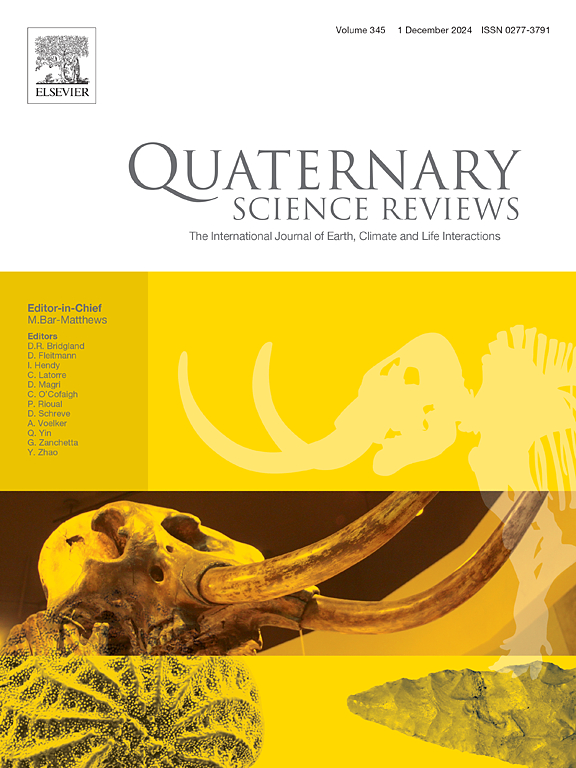Evolution of Indian monsoon precipitation and vegetation dynamics in the Bay of Bengal region since the last glacial period
IF 3.3
1区 地球科学
Q1 GEOGRAPHY, PHYSICAL
引用次数: 0
Abstract
The Indian Summer Monsoon (ISM) is among the major global climate systems and influences one-quarter of the world's population. However, the long-term variability of ISM precipitation from the last glacial to the present remains a subject of major debate. One debate concerns the precipitation change driven by the ISM from Marine Isotope Stage (MIS) 2 to MIS 1, while another focuses on the varying degrees of monsoonal rainfall intensity across different warm periods (MIS 3 and MIS 1). In this study, we reconstruct high-resolution palynological records from two sediment cores (YDY10 and E87-32B) in the Bay of Bengal (BoB) to explore changes in regional vegetation and ISM precipitation since the last glacial period. The results show that the concentrations of terrigenous pollen-spore decrease with increasing offshore distance, primarily reflecting pollen-spore input and transportation from the Ganges-Brahmaputra (G-B) river basins. Significant shifts in evergreen broad-leaved pollen at ∼40.5 ka and ∼12 ka indicate notable changes in hydrodynamic forces and intense precipitation, reflecting strong ISM activity. Data from core E87-32B indicate that ISM precipitation during the early to middle Holocene (MIS 1) was higher than during MIS 3, likely influenced by summer solar insolation (SSI) on an orbital timescale. From the Last Glacial Maximum (LGM) to the middle Holocene in MIS 1, the region experienced a transformation from extensive herbaceous vegetation to tropical and subtropical broad-leaved forests, followed by millennial-scale fluctuations in ISM precipitation in both cores. In core YDY10, broad-leaved forest pollen shows three distinct low values corresponding to Heinrich 1 (H1), Younger Dryas (YD), and the 8.2 ka cold and dry events, respectively, consistent with variations in the weakened Atlantic meridional overturning circulation (AMOC). Meanwhile, in core E87-32B, the broad-leaved pollen percentage increase from the LGM to the early and middle Holocene, indicating stronger ISM precipitation and G-B river input. This suggests that the ISM variation in this period was driven by AMOC and other factors, such as river input. Overall, this study offers a comprehensive perspective on past climate and vegetation dynamics around the BoB region on orbital and millennial timescales and contributes to a better understanding of the controls on monsoonal rainfall under different boundary conditions.
末次冰期以来孟加拉湾地区印度季风降水和植被动态演变
印度夏季风(ISM)是全球主要气候系统之一,影响着世界四分之一的人口。然而,从末次冰期到现在的ISM降水的长期变化仍然是一个主要争论的主题。一个争论是关于从海洋同位素阶段(MIS) 2到MIS 1的降水变化,另一个争论是关于不同暖期(MIS 3和MIS 1)季风降雨强度的不同程度。在本研究中,我们重建了孟加拉湾(BoB)两个沉积物岩芯(YDY10和E87-32B)的高分辨率孢粉记录,以探讨末次冰期以来区域植被和ISM降水的变化。结果表明,陆源花粉孢子浓度随离海距离的增加而降低,主要反映了来自恒河-雅鲁藏布江流域的花粉孢子输入和输送。在~ 40.5 ka和~ 12 ka,常绿阔叶花粉的显著变化表明水动力和强降水发生了显著变化,反映了ISM的强烈活动。E87-32B岩心数据表明,全新世早期至中期(MIS 1) ISM降水明显高于MIS 3,这可能是受夏季太阳日照(SSI)在轨道时间尺度的影响。从末次盛冰期(LGM)到全新世中期,该地区经历了从广泛的草本植被到热带和亚热带阔叶林的转变,随后两个岩心的ISM降水出现了千年尺度的波动。在YDY10核心,阔叶林花粉表现出三个明显的低值,分别对应于Heinrich 1 (H1)、Younger Dryas (YD)和8.2 ka冷干事件,与减弱的大西洋经向翻转环流(AMOC)变化一致。与此同时,E87-32B岩心的阔叶花粉比例从全新世早期到中期呈上升趋势,表明ISM降水和G-B河输入较强。这表明这一时期ISM的变化是由AMOC和其他因素(如河流输入)驱动的。总体而言,本研究提供了在轨道和千年时间尺度上对BoB地区过去气候和植被动态的全面视角,有助于更好地理解不同边界条件下对季风降雨的控制。
本文章由计算机程序翻译,如有差异,请以英文原文为准。
求助全文
约1分钟内获得全文
求助全文
来源期刊

Quaternary Science Reviews
地学-地球科学综合
CiteScore
7.50
自引率
15.00%
发文量
388
审稿时长
3 months
期刊介绍:
Quaternary Science Reviews caters for all aspects of Quaternary science, and includes, for example, geology, geomorphology, geography, archaeology, soil science, palaeobotany, palaeontology, palaeoclimatology and the full range of applicable dating methods. The dividing line between what constitutes the review paper and one which contains new original data is not easy to establish, so QSR also publishes papers with new data especially if these perform a review function. All the Quaternary sciences are changing rapidly and subject to re-evaluation as the pace of discovery quickens; thus the diverse but comprehensive role of Quaternary Science Reviews keeps readers abreast of the wider issues relating to new developments in the field.
 求助内容:
求助内容: 应助结果提醒方式:
应助结果提醒方式:


